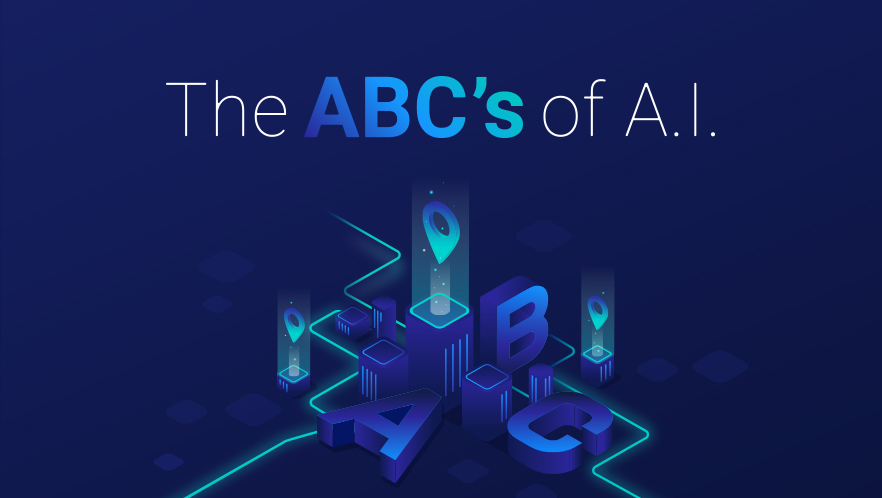The ABC’s of A.I. — How it’s transforming commercial real estate, restaurants, and retail
How artificial intelligence and machine learning technologies are transforming commercial real estate, restaurants and retail
Sci-fi depictions of artificial intelligence are everywhere in Hollywood, from the futuristic fantasies of 2001’s A.I., about a child-robot, and 2014’s Ex-Machina, about a humanoid A.I-enabled robot, to the classic A.I.-is-evil flick, 1984’s Terminator. With these sometimes frightening visions of autonomous machines taking over the world, it’s no wonder that many people find the whole notion of A.I. confusing at best and anxiety-provoking at worst.

At the same time, A.I., as well as subsets such as machine learning and neural networks, have become some of the most hyped business buzzwords of the 21st century. A.I.-powered services now serve as the foundation for a host of applications related to digital transformation and data analytics. Platforms using A.I. serve as the launching pad for daily-life staples such as Amazon’s Alexa, Apple’s Siri, Google Maps, and Netflix recommendations. The term has even replaced the former jargon star “big data” as the latest red-hot obsession, according to research firm CBInsights.
Breaking down the buzzword: What is A.I.?
So what is artificial intelligence, anyway? At its core is the idea that machines can help humans do what we have always done — interpret the world around us and learn from information we’ve gathered — in a more efficient, accurate way. Based on algorithms, artificial intelligence makes it possible for machines to learn from experience, perform tasks traditionally performed by humans, and adjust to new inputs that humans provide.
This is no newfangled idea: In fact, the term was coined well over a half century ago, in 1956, with early research focused on problem-solving. But according to the MIT Technology Review, the computational power of today’s machines has grown by leaps and bounds, so artificial intelligence is finally getting smart enough to make changes that are taking nearly every industry to the next level.
That doesn’t mean the robots are taking over, though: In fact, in a recent Harvard Business Review interview, Erik Brynjolfson, co-author of Machine, Platform, Crowd: Harnessing Our Digital Future, pointed out that while machines have become quite powerful and in many ways are superhuman, their intelligence is quite narrow. They can do amazing things within applications such as speech recognition, data analytics, or digital imagery, for instance, but “they don’t have general intelligence the way humans do.” That’s why, he explains, “partnerships of humans and machines are often going to be the most successful in business.”
Another buzzword, “machine learning,” is often used interchangeably with A.I., but it is actually a narrower term. With A.I., machines carry out tasks “intelligently” based on algorithms and adjustments to new inputs. Machine learning, on the other hand, is a subset of that, focusing on the ability of machines to process data and begin to learn for themselves, changing algorithms as they learn more about the information. Finally, a neural network is one group of algorithms used for machine learning, with mathematical models that mimic neurons in the brain.
Overall, A.I., machine learning, and neural networks seem destined to impact nearly every business function across industries, from customer service, marketing, and human resources to operations, finance, and data analytics. According to recent research from PwC, 72 percent of executives believe A.I. will be the “business advantage of the future,” with huge potential to optimize business efficiency and labor productivity (67 percent), automate proactive communications (70 percent), and improve big data analytics (59 percent). In the immediate future, execs are looking for A.I. to alleviate repetitive, menial tasks, such as filing paperwork (82 percent), scheduling workers (79 percent), and completing timesheets (78 percent).
A.I. in commercial real estate, restaurants, and retail
For those in the commercial real estate, restaurant, and retail industries, the battle for brick-and-mortar success shows no sign of letting up: Retailers have to compete for customer loyalty and grapple with growing e-commerce dominance. Restaurants are looking for seamless efficiency in an industry with razor-thin margins. In commercial real estate, developers and agents are looking to optimize opportunities and grow profits in an ever-changing environment.
Not surprisingly, these industries have taken major strides down the path towards integrating A.I. into a variety of business functions. Here are some significant ways A.I. is changing the game in these fast-paced, competitive verticals:
-
Customer-service chatbots
Chatbots, which are simple A.I.-powered computer programs that interact with customers through messaging or text, are transforming the customer-service experience for millions of buyers. These are some of the ways chatbots are being used by top brands and companies across the United States.
-
Ordering food: When customers place an order, they increasingly want the process to be easier, faster and more seamless than ever. Companies like Domino’s Pizza are taking that next-level step: Customers can order through a chatbot on the company website as well as through Facebook Messenger and SMS text. The Domino’s chatbot even allows users to text emojis of pepperoni pizza as food orders — a popular choice for Millennial and Gen Z customers.
-
Improving the retail shopping expereience: During the holidays, there are plenty of customers who can use a little extra help. In 2017, the Mall of America, North America’s largest shopping center, implemented a location-based A.I. chatbot program called Pepper to engage with consumers on the mall’s website, mobile app, and Facebook page, as well as a voice-activated skill to access the bot through Amazon’s Alexa. Along with food and event recommendations, the bot was able to give directions, answer questions about deals, and recommend gifts.
-
Leasing office space: In the commercial real estate industry, a startup called Truss simplifies the process of finding and leasing small to midsize office spaces with an A.I.-powered platform featuring a chatbot named Vera. Tenants can chat with throughout the search process about tenant requirements, monthly rental costs, and lease types.
-
-
Managing manufacturing and supply chains:
As consumers demand quick, seamless delivery and retailers look to boost efficiency, companies have turned to A.I.-powered applications to make processes more predictable and automated. Here are some ways A.I. is helping them tackle these challenges:
-
Optimizing workflows: Walmart recently announced that it’s partnering with Microsoft for cloud technology and artificial intelligence that will make it easier to streamline deliveries and cut costs as the brand continues to expand its online offerings to include grocery pickup and installation of smart-home technology.
-
Automating the manufacturing process: Companies have begun to use neural networks that “automatically learn what distinguishes good parts from not good parts on an assembly line with incredible speed.” For example, A.I.can detect a bad Oreo cookie from a good one, immediately removing it from the production assembly line.
-
Predicting supply and demand: Amazon is famous for its e-commerce recommendations, which are driven by machine learning. But the insights gained by those algorithms also help to predict demand for inventory, making supply decisions easier.
-
-
Commercial real estate investment, property management, and maintenance
Commercial real estate hasn’t traditionally been on the leading edge of technology use, but firms are now turning to artificial intelligence for an edge in a variety of areas. Here’s how they are upping the A.I. ante:
-
Investor analytics: Thanks to intelligent bots, real estate investors can monitor income and growth goals, assess risk-based on investor parameters, and make adjustments along the way to help meet financial goals.
-
Property management: Artificial intelligence can be used to monitor and predict when critical maintenance systems are ready for replacement, as well as keep track of rental trends by geographical areas and automatically raise rents when leases end.
-
Lower insurance costs: Maintenance costs in commercial real estate can quickly skyrocket, especially with inefficiencies throughout the process, from hiring staff to maintaining equipment. A.I. can link the whole value-chain through predictive analytics: for example, ongoing equipment monitoring can make sure proactive maintenance activities are tackled before a breakdown even occurs.
-
-
Real estate site selection
Historically, a commercial real estate broker’s intuition might have been the main factor in site selection. In recent decades, location-based predictive modeling has vastly improved the process of choosing locations, but it has been a slow, expensive process. A.I. and machine learning are now a game changers, helping users create a fast, accurate predictive model on their own. Here’s how the real estate site-selection process is transforming through A.I.:
-
Quick site-selection answers: Today’s users expect responses in realtime, not in weeks or months. They want to get the up-to-date site-selection answers they need on the go. Machine learning and automation is the only way to make this possible, by consuming and synthesizing hundreds, or thousands, of data points — more than any human could possibly do in a short amount of time.
-
Dynamic information: The end user is in complete control with the latest machine learning–based location intelligence solution — able to constantly update, refine, iterate, and test different scenarios. This is starkly different than providers that deliver project-oriented, stale deliverables that only get refreshed annually or upon the request of the client, at which point the consultant has to update the model and redeliver the platform.
-
Infinite variables: Legacy networks may only use a half dozen variables regardless of the location. Leveraging cutting-edge machine learning not only means being able to handle an infinite number of variables but also understanding how all those attributes impact each other based on the reality on the ground at individual locations.
-

Get empowered with A.I.
These days, retailers, restaurants and commercial real estate firms are navigating a variety of challenges in a competitive, constantly-evolving landscape. All industries are looking to be more efficient, nimble and flexible and A.I.-driven applications have the capability to solve complex problems, make calculations no human could, and interpret data easily and accurately. This puts businesses in a powerful position to grow and innovate with confidence.
Want to find out more about how A.I. and machine learning can take your location-based predictive modeling soaring to site selection success? Visist www.sitezeus.com for more information.
Save this resource for later
Tell us a bit about yourself, and we’ll get you a copy of this resource.
Recommended Posts
